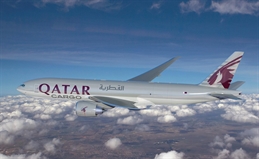
Qatar Airways is upbeat about its cargo business in what it thinks will be a decent year ahead, with a growing fleet and an ever-expanding network.
The airline received its 16th Boeing 777F in March and is due to receive five more during the summer, bringing the freighter fleet to a total of five Airbus A330-200Fs, two 747-8Fs and 21 777Fs.
“That’s a significant capacity addition and will obviously keep us busy for the rest of the year,” said Guillaume Halleux, chief cargo officer of Qatar Airways, in an interview during the International Air Transport Association’s World Cargo Symposium in Singapore. “At the same time, our belly capacity is also growing with more and more passenger widebody deliveries.”
He added that what will also keep his team busy this year is the opening of new stations.
“Among the new passenger destinations our CEO has recently announced, Lisbon is a good one and we’re pretty pleased,” he said. “We have also increased capacity in South Korea with an additional freighter.”
Overall, Halleux said that, while the reality is that market growth is slowing down, things are not as negative as some make it out to be, at least from Qatar Airways’ perspective.
“Hong Kong and Shanghai are impacted quite a bit, and the US is affected,” he said. “Nobody can deny that. But other parts of the world continue to grow. Southeast Asia is growing. Europe isn’t doing too badly and India is doing well. Let’s not forget that we have just finished 24 months of consecutive growth, which was pretty much unheard of in the industry for a few decades.”
The carrier remains confident about 2019 and expects a double-digit growth rate for its cargo business.
“I know I can grow my own business because my cost base is right, the hub is right, my service level is right, and customer demand is there,” said Halleux. “At the end of the day, with the current yield and the current fuel cost, I’m still profitable. Yes, there will be challenges. We have seen a lot of movement in the market and our customer distribution is changing, but as long as we have people lining up to take over the capacity, I’m fine with that. Our load factor is still pretty stable and I don’t see the industry going into an overcapacity situation any time soon.”
Qatar Airways Cargo began the year with the addition of Guadalajara as a stop on its trans-Pacific flight, launched in October 2018 with a 777F flying twice a week from Doha to Macau, Tokyo, Los Angeles and Mexico City before returning to Doha via Liege.
“The service works beautifully,” said Halleux. “I would like to express my gratitude to the forwarders that supported us in this initiative. This was very much out of the box but the market followed us. We will grow that service. Those that supported us from day one will not be disappointed because we will grow significantly.”
According to Halleux, the selection of Macau was purely due to the constraints the airline is facing in Hong Kong in terms of slots.
“With ATC, runway and noise limitations, the possibility to grow was marginal,” he said. “We want big growth. The next growth opportunity would be with the third runway and additional ATC corridors, but in seven to eight years’ time. I can’t wait eight years. So we had to look for alternatives and the best one was Macau.”
Given how quickly Southeast Asia is growing, Halleux said that he and his team are also exploring the possibility of trans-Pacific flights from that region.
Qatar Airways launched its second new freighter destination of the year when it began serving Almaty with a twice-weekly 777F in January.
“Almaty was traditionally an oil and gas market, but we did not find it interesting enough purely with that sector,” said Halleux. “Then we were presented with a sizeable e-commerce opportunity from a large retailer and that gave us a base load. That plus the oil and gas business makes it a very interesting operation for us.”
Qatar Airways Cargo’s second terminal at its Doha hub was put on hold after Qatar’s neighbours cut diplomatic ties with the country in June 2017, but now that the carrier is certain that cargo has not been affected, the project has been reactivated, albeit with a slightly extended timeline.
“We have found ways to accommodate our growth without building a whole new terminal, at least for the next two to three years,” said Halleux. “But these mitigating initiatives will only serve us so much, so the second terminal definitely will happen. In the meantime, we’ve freed up every possible square inch of the airport and converted it into storage and staging areas. We’ve also built up lighter infrastructure facilities. We’ve managed to free up a lot of space that wasn’t originally meant for cargo.”
The carrier also built a separate airside facility in 2017 to address demand for temperature-controlled solutions.
“Now we already need to contemplate an extension of our Climate Control Centre because we’ve been so successful in the pharma and perishable businesses,” Halleux said. “We’re doubling our fleet of reefer trucks this year because the business is really growing fast.”
While Halleux thinks it’s only a matter of time before Qatar Airways reaches the top position in IATA’s international FTK rankings, he said that he keeps reminding his teams that that is not the goal in itself.
“It’s more about customer service and preference, because if you get that, then when the market is good you get the better yield, and when the market is down you’re the last one to be cut,” he said. “It’s as simple as that and that’s what we strive for.”
By Jeffrey Lee
Asia Cargo News | Singapore



